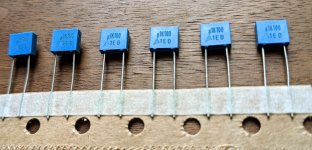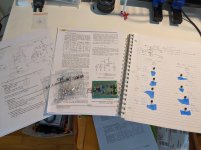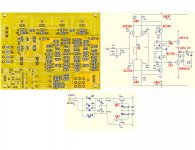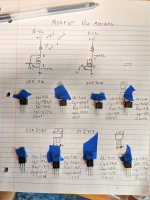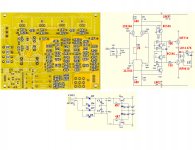List of cap substitutions from Mouser
Thanks Zung and Patrick for your responses.
This is really interesting stuff, I appreciate you sharing your experience. I might experiment with modifying the PSU down the line. This will be my first headphone amp so I will have nothing to compare it to initially.
Per Zung's advice, I'm going to replace all the capacitors that came with the kit. I'm operating under one self-imposed constraint: I want to stick to in-stock parts available from Mouser (I know: Digikey has some stuff that Mouser doesn't, I'm just loyal to Mouser) so as to not wait an eternity for shipping from China.
So, I've come up with a detailed substitution list w/ Mouser links that I've shared as a Google doc here. Hopefully some others who want to get all their caps in one place might find it useful.
As for the low-value caps, here's what I've settled on:
Let me know if you have any feedback on the above. Hopefully the list will be helpful to others building the same board under similar constraints (capacitor footprints, budget, shipping lead time).
Thanks again!
Thanks Zung and Patrick for your responses.
Regarding the sound of passive vs active PSU, I did an experiment about 40 years ago[...]
This is really interesting stuff, I appreciate you sharing your experience. I might experiment with modifying the PSU down the line. This will be my first headphone amp so I will have nothing to compare it to initially.
Per Zung's advice, I'm going to replace all the capacitors that came with the kit. I'm operating under one self-imposed constraint: I want to stick to in-stock parts available from Mouser (I know: Digikey has some stuff that Mouser doesn't, I'm just loyal to Mouser) so as to not wait an eternity for shipping from China.
So, I've come up with a detailed substitution list w/ Mouser links that I've shared as a Google doc here. Hopefully some others who want to get all their caps in one place might find it useful.
As for the low-value caps, here's what I've settled on:
- 22pF ceramics - replace with 22pF silver mica minis from CDE
- 100pF ceramics - replace with 100pF silver mica minis from CDE (a cheaper alternative that would still *barely* fit the board: WIMA FKP2 Polypropylene)
- .1uF blue box-type bypass caps (pic attached, probably polyester given the form factor) - there's not much space on the board for these, so I plan to replace the supplied ones with with .1uF PPS caps from Kemet (from what I'm reading, Polyphenylene Sulfide seems a better alternative to Polyester without the massive size of Polypropylene)
Let me know if you have any feedback on the above. Hopefully the list will be helpful to others building the same board under similar constraints (capacitor footprints, budget, shipping lead time).
Thanks again!
Attachments
Better than mica, IMHO :
https://www.surplussales.com/capacitors/Poly-Unelco.html
And for PPS, I use :
ECH-U1H104GX9 Panasonic | Mouser Europe
Patrick
https://www.surplussales.com/capacitors/Poly-Unelco.html
And for PPS, I use :
ECH-U1H104GX9 Panasonic | Mouser Europe
Patrick
Better than mica, IMHO :
https://www.surplussales.com/capacit...ly-Unelco.html
Thanks for the suggestion -- that's a cool supplier. Now I'm paralyzed with indecision, when I should probably stop obsessing over what amounts to 6 caps in a project I'm doing for fun.
I'm reading that though polystyrene has advantages over silver mica, and those caps you linked are certainly much cheaper than the micas, they can sometimes melt in high-temperature applications. Something to be concerned with when soldering these types of caps? (I've never built with either type before, only polyester film and electrolytics).
Mica is basically a rock: it withstands 900°C/1,650°F and doesn't fear anything.
Polystyrene (PS) is at the opposite end of the spectrum and melts at 100°C. I did my share of killing of the older types like those linked by EUVL, not by soldering, but by accidentally touching the body with the soldering iron. I like the Philips PS for phono EQ and filtering; they are 1% and housed in a metal tube, and I've never managed to kill any of those so far. They are discontinued but still available off eBay at reasonable price. They have iron leads (evil), and of course they're overkill for compensation.
I wouldn't worry too much about soldering in general, the through hole types are actually very kind to the components. You should see the SMD soldering for a scare; lots of these on Youtube.
Polystyrene (PS) is at the opposite end of the spectrum and melts at 100°C. I did my share of killing of the older types like those linked by EUVL, not by soldering, but by accidentally touching the body with the soldering iron. I like the Philips PS for phono EQ and filtering; they are 1% and housed in a metal tube, and I've never managed to kill any of those so far. They are discontinued but still available off eBay at reasonable price. They have iron leads (evil), and of course they're overkill for compensation.
I wouldn't worry too much about soldering in general, the through hole types are actually very kind to the components. You should see the SMD soldering for a scare; lots of these on Youtube.
What about COG ceramics?
I have received recommendations about them from audio serious people. Probably not as good as polystyrenes (never had any problem soldering them, that must be done quick), but apparently comparable to polyprops.
They come in wire ended versions, are cheap, and probably worth a try from Mouse.
And certainly do keep away from iron leads: they are bad for audio.
I have received recommendations about them from audio serious people. Probably not as good as polystyrenes (never had any problem soldering them, that must be done quick), but apparently comparable to polyprops.
They come in wire ended versions, are cheap, and probably worth a try from Mouse.
And certainly do keep away from iron leads: they are bad for audio.
They come in wire ended versions, are cheap, and probably worth a try from Mouse.
Boa noite, carlmart. Appreciate the suggestion.
Vishay C0G's are dramatically cheaper than the small CDE Silver Micas I found on Mouser. $1.14 for the 6 C0G ceramics (example) versus nearly $19 for the 6 Silver Mica's (more than I paid for the kit if you don't include shipping!)
I found a few threads in which folks suggest them as a good choice for compensation, though opinions vary.
- Miller Cap: C0G, Mica or Polystyren?
- ceramic capacitors ....
- Is this vishay MLCC good for compensation cap?
- compensation cap recommendation? is conventional Ceramic NP0?
No disrespect to Zung and Patrick's input here, but the lower price and convenience of not needing to put in a separate order w/ shipping is winning me over to the C0G/NP0 camp.
I apologize for turning this into a capacitor conversation. I promise to update the thread with more useful information and photos as I proceed with the build itself.
I just discovered this post from John Curl over in the JC-2 clone thread where Zung originally started posting about this HPA.
So, I shall pay the piper (USPS in this case) and go with the polystyrenes.
Meanwhile, I was looking through my Aliexpress receipts and noticed I did purchase a dual pre-regulator board at the same time as the kit, transformer, and enclosure. So I may indeed follow the recommended PSU mods whenever it arrives. I believe it's still in China, or stuck in customs, or somewhere over the ocean -- as is the enclosure itself.
I just discovered this post from John Curl over in the JC-2 clone thread where Zung originally started posting about this HPA.
You should replace C2 and any other parts like it with mica or polystyrene. This is important.
So, I shall pay the piper (USPS in this case) and go with the polystyrenes.
Meanwhile, I was looking through my Aliexpress receipts and noticed I did purchase a dual pre-regulator board at the same time as the kit, transformer, and enclosure. So I may indeed follow the recommended PSU mods whenever it arrives. I believe it's still in China, or stuck in customs, or somewhere over the ocean -- as is the enclosure itself.
Metaphile,
As all things in audio, better to listen check things first. Particularly on capacitors, and particularly when they are placed in critical places.
In my case I have little doubts: if available I would always go with polystyrenes. It's a pity they were never made higher than 100n, but I did use them in parallel to get to 500n for input cap. Best input cap I ever had. Completely invisible, no colour of any kind, as a cap should be.
Don't hold silver micas as high as many people do. But I must confess I never gave them a fair chance, as trying them was expensive.
Recently I was making a BOM for some projects I'm working on (a Luxman power amp clone and discrete RIAA clone), which went into stand by with the pandemic thing, and I think I will buy both polystyrenes and COGs. COGs have more available values, particularly in 2pF to 10pF for compensation parallels.
Now, another area you mention is the regulator for this HPA, and I wonder if you could read about the Denoisator option, that can be added to regulators you may already have, particularly 3X7 ones. Heard about them?
D-Noizator: a magic active noise canceller to retrofit & upgrade any 317-based V.Reg.
No need to read all 73 pages, I think reading the last 10 might be enough, if memory helps.
I did many LTSpice simulations with power supplies, some were uploaded to that topic, some I can provide if interested.
If your regulators are based on 3X7, LT1085 or fixed ones, like 78XX and 79XX, you should definitely give them a try. You can add small piggybacks with the mod parts, and people that tried them were very satisfied.
Sim results, particularly on Diego's mod of the mod, are spectacular in PSRR, impedance and noise, comparable or better to Jung/Didden superregulators. And with no expensive hard to find legit parts for, like FETs in Salas regulators.
As all things in audio, better to listen check things first. Particularly on capacitors, and particularly when they are placed in critical places.
In my case I have little doubts: if available I would always go with polystyrenes. It's a pity they were never made higher than 100n, but I did use them in parallel to get to 500n for input cap. Best input cap I ever had. Completely invisible, no colour of any kind, as a cap should be.
Don't hold silver micas as high as many people do. But I must confess I never gave them a fair chance, as trying them was expensive.
Recently I was making a BOM for some projects I'm working on (a Luxman power amp clone and discrete RIAA clone), which went into stand by with the pandemic thing, and I think I will buy both polystyrenes and COGs. COGs have more available values, particularly in 2pF to 10pF for compensation parallels.
Now, another area you mention is the regulator for this HPA, and I wonder if you could read about the Denoisator option, that can be added to regulators you may already have, particularly 3X7 ones. Heard about them?
D-Noizator: a magic active noise canceller to retrofit & upgrade any 317-based V.Reg.
No need to read all 73 pages, I think reading the last 10 might be enough, if memory helps.
I did many LTSpice simulations with power supplies, some were uploaded to that topic, some I can provide if interested.
If your regulators are based on 3X7, LT1085 or fixed ones, like 78XX and 79XX, you should definitely give them a try. You can add small piggybacks with the mod parts, and people that tried them were very satisfied.
Sim results, particularly on Diego's mod of the mod, are spectacular in PSRR, impedance and noise, comparable or better to Jung/Didden superregulators. And with no expensive hard to find legit parts for, like FETs in Salas regulators.
... In my case I have little doubts: if available I would always go with polystyrenes. It's a pity they were never made higher than 100n, but I did use them in parallel to get to 500n for input cap. Best input cap I ever had. Completely invisible, no colour of any kind, as a cap should be...
Actually they do: I bought these cheap Russian military 1uF/250V for a tube preamp I'm working on. It's not finished, so I can't say if they're good or not, but I'm pretty confident.
But then again, if you have a FET or a tube at the input, you don't need a cap.
Actually they do: I bought these cheap Russian military 1uF/250V for a tube preamp I'm working on. It's not finished, so I can't say if they're good or not, but I'm pretty confident.
But then again, if you have a FET or a tube at the input, you don't need a cap.
I know those Russian polystyrenes, and I think I bought some a few years ago. But I never get to to use them. Very large things for just 1uF. They are probably several 100n in parallel, as I had done.
But I don't count on parts sold on eBay for my projects. That's why I didn't mention then.
Now, another area you mention is the regulator for this HPA, and I wonder if you could read about the Denoisator option, that can be added to regulators you may already have, particularly 3X7 ones. Heard about them?
Nope -- haven't read that thread yet (though I've heard it mentioned). I'll give it a read! The pre-regulator I ordered is a cheapo one based on the LM317/337 so would benefit from the D-Noizator "magic".
P.S. I bought the C0G caps, too, since they were so cheap. Will experiment with both types. I'm no "golden ears" though, doubt I'd hear any difference. I also picked up a dummy load resistor that approximates the impedance of my headphones so I can take a look on a scope at the performance when the build is finished.
Good find!
These days, China is a bit of a gamble: I ordered these on Mar 8, and still get "In transit" after nearly 3 months. I do receive all the stuff I don't need though.
I ordered a board at the same time, haven’t seen it yet either.
Probably won’t be using the thing, regardless, is more of a spare at this point, maybe it’ll be a Christmas present!
I measured the IDSS of the JFETS (haven't measured the Yfs/Gm yet). I didn't control the temperature so take these #'s with a grain of salt.
2SJ103: 9.34, 9.45, 9.52, 9.52mA
2SK246: 9.71, 9.74, 9.77, 9.79mA
I tested the Yfs/Gm of the JFETs last night @ IDSS w/ a 104Hz signal (made a typo in the software -- should have been 100Hz) at 50mVrms. Shout out to Patrick for the test jig circuit.
In the same order as they appear above, measurements were:
- 2SJ103: 5.06mS, 5.12mS, 50.6mS, 5.08mS
- 2SK246: 3.82mS, 3.84mS, 3.80mS, 3.86mS
So my experience is very similar to Zung's -- close same-sex matching but not so w/ the opposite sex.
I also received the 100pF and 22pF polystyrene capacitors from surplus sales of Nebraska. They made a typo in the original address and my order was shipped to the wrong place but quickly sent another identical order to the correct address once I contacted them. Good customer service - will shop there again.
Pic attached of the JFETs, matching jig, caps, and some very helpful documentation
(On a personal note - I haven't even reached the FET chapter in Art of Electronics yet -- I'm still on the chapter about BJTs -- so this kit & thread have expanded my learning & gotten me peeking ahead)
Attachments
Hey folks,
Today I took the time to go through the PCB and the schematic offered by the supplier and label everything. I also marked up the schematic to reflect the resistor values on the PCB screenprint. Results are attached. If anyone who is planning on building one of these would like a high-resolution printable PDF, just message me and I'll share.
I also took the opportunity to test the Vgs of the MOSFETs @ 60mA -- both the supplied 2SK2381/2SJ407 pairs and the IRF710/IRF9610 I purchased from Mouser.
Results were as follows:
2SK2381:
2SJ407:
IRF710:
IRF9610:
I was pleased with the matching of the IRF710/IRF9610 pairs and will use those rather than the Toshibas.
Today I took the time to go through the PCB and the schematic offered by the supplier and label everything. I also marked up the schematic to reflect the resistor values on the PCB screenprint. Results are attached. If anyone who is planning on building one of these would like a high-resolution printable PDF, just message me and I'll share.
I also took the opportunity to test the Vgs of the MOSFETs @ 60mA -- both the supplied 2SK2381/2SJ407 pairs and the IRF710/IRF9610 I purchased from Mouser.
Results were as follows:
2SK2381:
- 3.025V
- 3.2V
2SJ407:
- 3.42V
- 3.17V
IRF710:
- 4.34V
- 4.34V
IRF9610:
- 4.32V
- 4.32V
I was pleased with the matching of the IRF710/IRF9610 pairs and will use those rather than the Toshibas.
Attachments
Whoops, just noticed a mistake in my markup of the seller's schematic.
LR14 & RR14 are actually 47K -- I had marked these up as .47K. Corrected annotated schematic attached.
Also note that I left out the protection circuit altogether. The 47K resistor appears to be a part of that -- it actually connects between the relay and the C137HA IC, so my clumsy addition of it to the schematic (see red hand-drawn box) isn't really accurate.
OK I've been at this too long -- time to go to bed.
LR14 & RR14 are actually 47K -- I had marked these up as .47K. Corrected annotated schematic attached.
Also note that I left out the protection circuit altogether. The 47K resistor appears to be a part of that -- it actually connects between the relay and the C137HA IC, so my clumsy addition of it to the schematic (see red hand-drawn box) isn't really accurate.
OK I've been at this too long -- time to go to bed.
Attachments
Sorry if I insist on this matter: has anyone tried a better voltage regulator?
Any listening changes?
Personally: I haven't built the amp at all yet. I'm taking my time with the preliminaries but will likely build it and test it w/ my bench power supply later this week.
The dual linear regulator kit I ordered is still somewhere in China but I'm intrigued by the D-Noizator thread you linked and will likely build one of those to attach to the dual linear regulator when it arrives. If and when I do I'll share some listening impressions, though I can't promise to deliver Stereophile or 6Moons-quality prose.
Not to veer off topic, carlmart - but where are you from in Brazil? I used to spend a lot of time there for work. Mostly São Paulo but also Belo Horizonte, a little bit in Rio de Janiero, and once took a leisure trip to Pantanal. I really miss spending time there.
- Home
- Amplifiers
- Headphone Systems
- The JC2-HPA Headphone Amplifier
